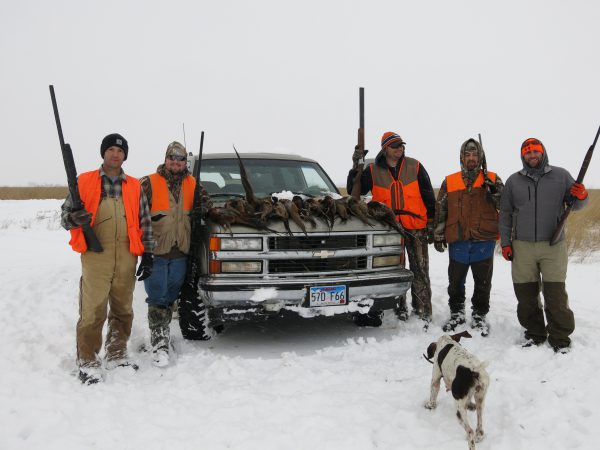End of Season Opportunities Abound
Category: article
Sep 27th, 2019 by Keith Worrall
Modified Sep 27th, 2019 at 10:11 AM
End of Season Opportunities Abound
Pheasant Hunting at its Finest
In my 50 plus years living, working and hunting here in Spink County, SD (where it all began with the first release of Chinese Ringneck Pheasants on land that is an integral part of my guided pheasant hunting operation) I have had the good fortune to observe and in turn, learn a great deal about pheasant habits and behavior patterns. In addition, I also receive regular reports from my self-guided clients that are sprinkled throughout the State.
A common theme that rises to surface is that late season-from Thanksgiving on-proves to be the best time frame for the most exciting hunts of the year. There are several reasons for this. The largest of these is the need for the birds to begin converging towards heavier cover. Cool directly equates to concentrations of birds. This is the true lure of late season. The perfect time to experience both the heart stopping and heart racing euphoria caused by the explosive flushes of numerous birds that tightly group into small patches of thick winter habitat.
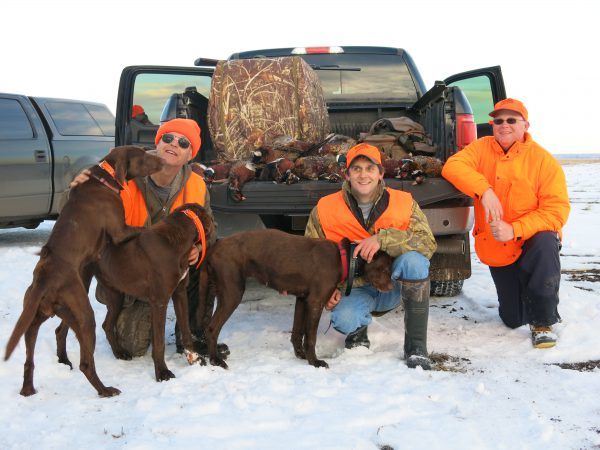
“Wise hunters enjoying the warm glow of winter success.”
Savvy hunters are increasingly choosing to witness the largest congregations of birds and conversely, lowest number of hunters pursuing them. The legions of hunters drawn for the rush of early season are now long gone. Leaving all of the large, mature and heavily feathered roosters for the relatively few of us willing to don a coat and adjust our tactics accordingly. The puffy and starkly colored plumage they are now donning is absolutely stunning against the scenic snowy white prairie background.
Tactics:
This is an affair best suited for smaller more intimate groups. Conditions dictate this as clear communication and ultimately, coordination is key. Big groups simply make this all but impossible to achieve. Our pheasants have now seen and have completely adapted to the fanfare of big sweeping drives with an army of those armed and looking to do them harm. Stealth is now paramount to success. I recommend groups no larger than 6 to 8. Or, about what you can fit into two vehicles. Three at the most. What is outlined as follows has served us well over the years.
The first order of business is to have all of your spots scouted out well in advance. This is best accomplished by simply driving the roads surrounding each potential parcel. Not directly in the field as winter birds are wary birds. You can glean all that is needed from the road and they pay little attention to passing vehicles. Mid-afternoon to early evening will find them feeding directly adjacent to heavy cover and they are easily spotted in groups ranging from dozens up to a hundred, or more. You can be all but assured they will be found in the nearby cover the next morning. You can even glass the edges to spot the tell-tale tracks where they are leaving and returning to further define small and precise areas of the cover you will want to focus your efforts on. This is a surgical strike scenario versus the carpet bombing campaigns of early season.
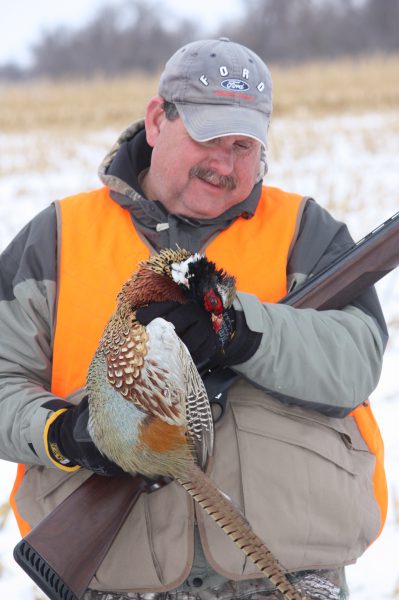
Once you have your locations chosen, it is key to have a firm game plan in place and have this effectively relayed and comprehended by all hunters in your group. If they are not familiar with the locations, it pays to have them quickly look the situation over to fully understand what is expected of them before ever stepping out of a vehicle. Stop a good half mile away with a good vantage point in order to do so. You can now take action and implement your plan.
And by action, I mean immediate action. This is not a time for delays and dallying about. The birds know full well you are there and what your intentions are. We just need to spring our trap before they get too nervous and bolt. And bolt they will. To keep them corralled, it is paramount to have all parties headed for the cover at the same time and pace so as to hit it simultaneously for best results. This is where small dense pieces of cover such as cattails sloughs of perhaps 5 acres or so are preferred. Via your scouting intel you can often find fingers, edges and ends of much larger sloughs will work equally well. The key is to concentrate your efforts on confining the birds to manageable spots where the odds of having reasonable shots is upped.
I would recommend surrounding your chosen piece so as to hem in and eliminate all of the birds escape routes. In order to do so, quickly and quietly park up to a quarter of a mile away, depending on how spooky the birds are. Have every possible thing ready so you can step out of the vehicle and immediately head for the cover at the same exact time your counterparts are. Quiet is mandatory. If you have dogs that like to bark or partners that feel a need to yap too, leave em at home. They will blow the hunt just as quickly as slamming your doors will. Wind is helpful as it muffles your approach. In this case, it is wise to have your fastest and best shooters approaching into the wind as the birds will most likely take flight using the wind to instantly gain speed and quickly distance themselves out of range. Hence, quick and accurate shots are paramount for bringing them back down to earth.
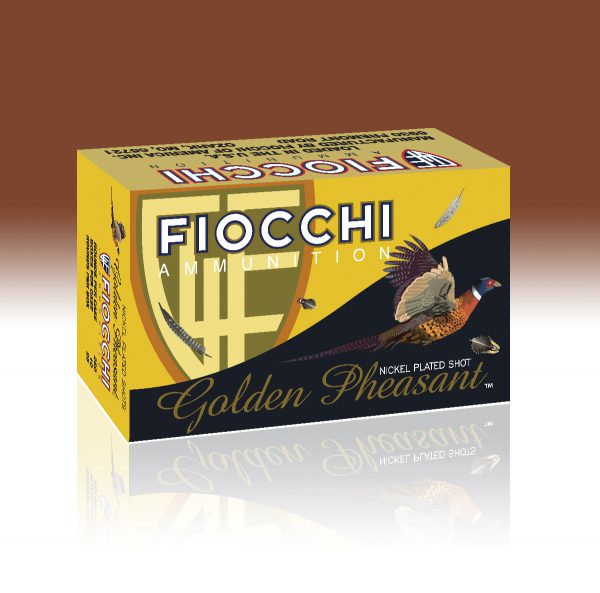
“Pretty-yet tough-birds deserve the use of premium ammo.”
On the subject of shots and shot itself, I strongly encourage you to use only 12 gauges with 3 inch shells for late season pheasants. These are all mature, tough and densely feathered birds that require nothing smaller than 4 shot and with that, preferably copper or nickel-plated lead. You should go with the fastest premium loads from reputable shell companies. A staple for us the last several years has been Fiochhi’s Golden Pheasant offering. Pumping out an ounce and three quarters of hard and symmetrical nickel-plated shot at a quite lethal 1,200 feet per second. You will find shells like this hit much harder and penetrate deeper for clean and ethical kills. You will also be pleasantly surprised to discover the shot does not deform and therefore, no feathers are driven into the meat and shot generally falls out during the rinsing part of cleaning. Being cheap and saving a few dollars will end up costing big time. I would further recommend going with an improved modified or tighter choke and the use of auto’s is preferred for quick follow up shots. If they do not immediately plummet to the ground, hit em again to ensure they don’t sail off into the distance.
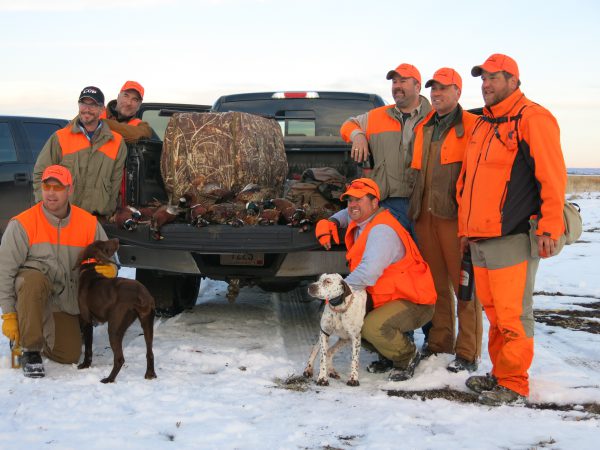
Late season roosters are quite literally, wise old birds that have the inherent instincts to have made it this far. Their sole purpose is to be around to breed in the Spring, despite our efforts at putting them on a plate. They are cagey and hard to capture. Employ the general tactics I have discussed and be ready to adapt and learn from each and every walk, every day you are in the field. Conditions can and do change and you must be ready to do so as well. Be observant, adjust tactics as needed and you will be rewarded with the most beautiful of game birds in their prime and peak condition.
Additional notes:
You will find that gaining an opening for a hunt with an outfitter is easier, as (please excuse the jab) the fair-weather hunters are now long gone. You will also find far less competition for accessing public land. Furthermore, public land can be surprisingly desirable as much of it consists of heavy cattail sloughs and shelterbelts that are so productive during this period. I would also suggest that you do not repeatedly hunt the same areas, particularly during cold snaps. It is already stressful for the birds and rousting them out of their winter havens just adds to that. Furthermore, if you continually hit the spots, the birds will be hesitant to return due to continual pressure and be forced to find new winter habitat and losses incur in doing so. Most often in our ever so important breeding hens. A little common sense goes a long-ways toward conservation.
That being said, if we continue to support conservation efforts-thankfully-we have an endlessly renewable resource. I implore you to be active and support conservation organizations like Pheasants Forever to ensure a future full of opportunities. Come on out and sample some of the late season action for yourself. You will find the folks here in South Dakota to be most welcoming and the relaxed pace will allow to enjoy all of the hospitality extended.

